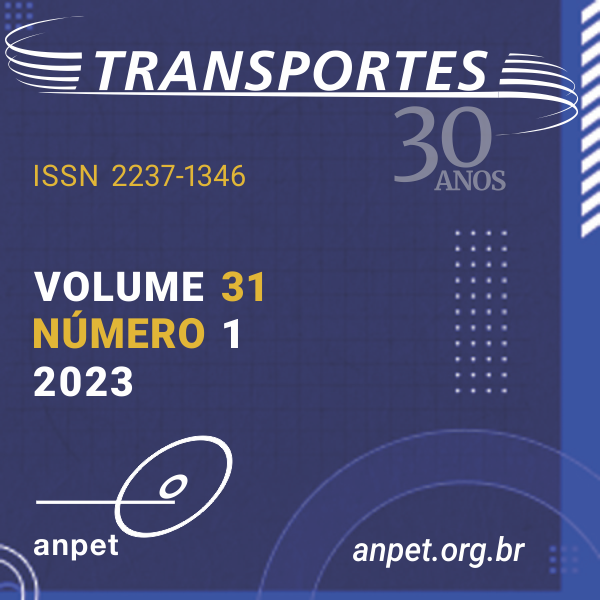Melhorando projeto geométrico de estradas através de uma técnica de visualização em realidade virtual
DOI:
https://doi.org/10.58922/transportes.v31i1.2838Palavras-chave:
Projeto de Rodovia, Simulador de Direção, Realidade virtual imersivaResumo
Acidentes de trânsito muitas vezes poderiam ser evitados com estudos mais aprofundados do tráfego e do traçado geométrico, usando, por exemplo, simuladores de direção para simular as condições do trânsito. O objetivo deste estudo é avaliar qualitativamente três tipos de técnicas de visualização para examinar um projeto rodoviário, uma em um projeto impresso em 2D e as outras usando um simulador de direção em um sistema de imersão virtual e visualização em tela. Os resultados foram avaliados pelo método Analytic Hierarchy Process-AHP, utilizado para estabelecer diferentes pesos para as variáveis analisadas. Para isso, foi aplicado um questionário aos alunos de graduação em Engenharia Civil para comparar as técnicas. Os resultados mostram que a visualização em simulação imersiva tem qualidade suficiente e pode contribuir muito para a validação de projetos geométricos.
Downloads
Referências
Ahlström, C., Anund, A., Fors, C. and Åkerstedt, T., (2018) The effect of daylight versus darkness on driver sleepiness: a driving simulator study. Journal of Sleep Research, v.27, n.3, p. 1-9. DOI: 10.1111/jsr.12642. DOI: https://doi.org/10.1111/jsr.12642
Babić, D. and Brijs, T., (2021) Low-cost road marking measures for increasing safety in horizontal curves: A driving simulator study. Accident Analysis and Prevention, v. 153, p. 106013, DOI: https://doi.org/10.1016/j.aap.2021.106013. DOI: https://doi.org/10.1016/j.aap.2021.106013
Bacchieri, G. and Barros, A. J. D., (2011) Traffic accidents in Brazil from 1998 to 2010: many changes and few effects. Revista de Saúde Pública, v. 45, n. 5, p. 949-963, DOI: https://doi.org/10.1590/S0034-89102011005000069. DOI: https://doi.org/10.1590/S0034-89102011005000069
Bassani, M., Catani, L., Salussolia, A. and Yang, C., (2019) A driving simulation study to examine the impact of available sight distance on driver behavior along rural highways. Accident Analysis & Prevention, v. 131, n. 1, p. 200-212, DOI: https://doi.org/10.1016/j.aap.2019.07.003. DOI: https://doi.org/10.1016/j.aap.2019.07.003
Bella, F., (2009) Can driving simulators contribute to solving critical issues in geometric design? Transportation research record, v. 2138 n. 1, p. 120-126 DOI: https://doi.org/10.3141%2F2138-16. DOI: https://doi.org/10.3141/2138-16
Blissing, B., Bruzelius, F. and Eriksson, O., (2022) The Effects on Driving Behavior When Using a Head-mounted Display in a Dynamic Driving Simulator. ACM Transactions on Applied Perception, v. 19, n. 1, p. 1-18, DOI: https://doi.org/10.1145/3483793. DOI: https://doi.org/10.1145/3483793
Chang, X., Li, H., Qin, L., Rong, J., Lu, Y. and Chen, X. (2019) Evaluation of cooperative systems on driver behavior in heavy fog condition based on a driving simulator. Accident Analysis & Prevention, v. 128, n. 1, p. 197-205, DOI: https://doi.org/10.1016/j.aap.2019.04.019. DOI: https://doi.org/10.1016/j.aap.2019.04.019
CLIP, T., (2017) CLIP: Sistema integral para el deseño, evaluación y control de ejecución de obras lineales. [Online] Available at: https://tool.es/web/Clip.html [Acesso em 25 março 2022].
DataGeosis, O., (2005) O software de Topografia e Geodésia. [Online] Available at: http://www.datageosis.eng.br/index.cfm [Acesso em 25 março 2022].
Difei, J., Cancan, S., Zhongyin, G. and Ran, L., (2021) Influence of the median opening length on driving behaviors in the crossover work zone - A driving simulation study. Transportation Research Part F: Traffic Psychology and Behaviour, v. 82, p. 333-347, DOI: https://doi.org/10.1016/j.trf.2021.09.001. DOI: https://doi.org/10.1016/j.trf.2021.09.001
Dużmańska, N., Strojny, P. and Strojny, A., (2018) Can Simulator Sickness Be Avoided? A Review on Temporal Aspects of Simulator Sickness. Frontiers in Psychology, v. 9, p. 1-14, DOI: https://doi.org/10.3389/fpsyg.2018.02132. DOI: https://doi.org/10.3389/fpsyg.2018.02132
Farahmand, B. and Boroujerdian, A. M., (2018) Effect of road geometry on driver fatigue in monotonous environments: A simulator study. Transportation Research Part F: Traffic Psychology and Behaviour, v. 58, n.1, p. 640-651 DOI: https://doi.org/10.1016/j.trf.2018.06.021. DOI: https://doi.org/10.1016/j.trf.2018.06.021
Farooq, D., Moslem, S. and Duleba, S., (2019) Evaluation of Driver Behavior Criteria for Evolution of Sustainable Traffic Safety. Sustainability, v.11, n. 11, p. 3142, DOI: https://doi.org/10.3390/su11113142. DOI: https://doi.org/10.3390/su11113142
Gaweesh, S. M., Bakhshi, . A. K. and Ahmed, M. M., (2021) Safety Performance Assessment of Connected Vehicles in Mitigating the Risk of Secondary Crashes: A Driving Simulator Study. Transportation Research Record, v. 2675, n.12, p. 117-129, DOI: https://doi.org/10.1177%2F03611981211027881. DOI: https://doi.org/10.1177/03611981211027881
Hammad, H. M., Ashraf, M., Abbas, F., Bakhat, H. F., Qaisrani, S. A., Mubeen, M., Fahad, F. and Awais, M., (2019) Environmental factors affecting the frequency of road traffic accidents: a case study of sub-urban area of Pakistan. Environmental Science and Pollution Research, v. 26, n.1, p. 11674 –11685, DOI: https://doi.org/10.1007/s11356-019-04752-8. DOI: https://doi.org/10.1007/s11356-019-04752-8
Hussain, Q., Almallah, M., Alhajyaseen, W. K. and Dias, C., (2020) Impact of the geometric field of view on drivers’ speed perception and lateral position in driving simulators. Procedia Computer Science, v. 170, p. 18-25, DOI: https://doi.org/10.1016/j.procs.2020.03.005. DOI: https://doi.org/10.1016/j.procs.2020.03.005
Jayaram, S., Connacher, H. I. and Lyons, K. W., (1997) Virtual assembly using virtual reality techniques. Computer-Aided Design, v. 29, n.8, p. 575-584, DOI: https://doi.org/10.1016/S0010-4485(96)00094-2. DOI: https://doi.org/10.1016/S0010-4485(96)00094-2
Jeong, H. and Liu, Y., (2019) Effects of non-driving-related-task modality and road geometry on eye movements, lane-keeping performance, and workload while driving. Transportation research part F: traffic psychology and behaviour, v. 60, p. 157-171, DOI: https://doi.org/10.1016/j.trf.2018.10.015. DOI: https://doi.org/10.1016/j.trf.2018.10.015
Limpert, R., (2021) Motor vehicle accident reconstruction and cause analysis. 1 ed. Alemanha: 7th Edition.
Liu, T. and Xu, J., (2019) The influence rule of highway curve radius on speed perception and operating speed. IOP Conference Series: Earth and Environmental Science, v.371, n.2, p. 022080, DOI: 10.1088/1755-1315/371/2/022080. DOI: https://doi.org/10.1088/1755-1315/371/2/022080
Liu, Y., Castronovo, F., Messner, J. and Leicht, R., (2020) Evaluating the Impact of Virtual Reality on Design Review Meetings. Journal of Computing in Civil Engineering, v.34, n.1, p. 1-13, DOI: https://doi.org/10.1061/(ASCE)CP.1943-5487.0000856. DOI: https://doi.org/10.1061/(ASCE)CP.1943-5487.0000856
Moslem, S., Farooq, D., Ghorbanzadeh, O. and Blaschke, T., (2020) Application of the AHP-BWM Model for Evaluating Driver Behavior Factors Related to Road Safety: A Case Study for Budapest. Symmetry, v. 12, n. 2, p. 243-254, DOI: https://doi.org/10.3390/sym12020243. DOI: https://doi.org/10.3390/sym12020243
Mutar, H. S., Abduljabbar, A. S. and Mohammed, A. A., (2021) The Effect Of Mobile Phone Use While Driving On Response Time: Driving Simulator Study. Engineering and Technology Journal, v. 39, n. 12, p. 1806-1813, DOI: http://dx.doi.org/10.30684/etj.v39i12.2132. DOI: https://doi.org/10.30684/etj.v39i12.2132
Rift, O., (2017) VR Headset for VRs Ready PCs. [Online] Available at: https://www.oculus.com/rift/ [Acesso em 25 março 2022].
Ruiz, D. B., Saloman, V. A. P., Marins, F. A. S., Palominos, P., Marrone, L. A., (2021) State of the art review on the analytic hierarchy process and urban mobility. Mathematics, v. 9, p. 3179, DOI: https://doi.org/10.3390/math9243179. DOI: https://doi.org/10.3390/math9243179
Saaty, T. L., (1977) A scaling method for priorities in hierarchical structures. Journal of mathematical psychology, v. 15, p. 234-281, DOI: https://doi.org/10.1016/0022-2496(77)90033-5. DOI: https://doi.org/10.1016/0022-2496(77)90033-5
Saaty, T. L., (1983). Priority setting in complex problems. IEEE Transactions on Engineering Management, v. 3, p. 140-155, DOI: https://doi.org/10.1109/TEM.1983.6448606. DOI: https://doi.org/10.1109/TEM.1983.6448606
Scalco, L., Bordin, F., de Souza, E. M., Racolte, G., Marques Jr, A., Cunto, F. J. C., Silveira Jr, L., G., and Veronez, M. R. (2022) Driver behavior analysis on a curve through immersive simulation and a segmented regression model. TRANSPORTES, v. 30, n. 1, 2548. DOI: https://doi.org/10.14295/transportes.v30i1.2548. DOI: https://doi.org/10.14295/transportes.v30i1.2548
Shi, Y., Boffi, M., Piga, B. E. A., Mussone, L. and Cruso, G. (2022) Perception of driving simulations: Can the Level of Detail of virtual scenarios affect the drivers behavior and emotions. IEEE Transactions on Vehicular Technology, v. 71, n. 4, p. 1-15, DOI: https://doi.org/10.1109/TVT.2022.3152980. DOI: https://doi.org/10.1109/TVT.2022.3152980
TOOL, S., s.d. CLIP. [Online] Available at: https://www.tool.es/web/Clip.html [Acesso em 22 março 2022].
Unity, 3. G. E., (2016). Our digital humans are evolving. [Online] Available at: https://unity.com/pt Acesso em 25 março 2022].
Walch, M., Frommel, J., Rogers, K., Schussel, F., Hock, P., Dobbelstein, D. and Weber, M. (2017) Evaluating VR Driving Simulation from a Player Experience Perspective. Conference Extended Abstracts on Human Factors in Computing Systems, p. 2982–2989 DOI: https://doi.org/10.1145/3027063.3053202. DOI: https://doi.org/10.1145/3027063.3053202
Weidner, F., Hoesch, A., Poeschl, S. and Broll, W., (2017) Comparing VR and Non-VR Driving Simulations: An Experimental User Study. IEEE Xplore, p. 281-282, DOI: https://doi.org/10.1109/VR.2017.7892286. DOI: https://doi.org/10.1109/VR.2017.7892286
Wynne, R. A., Beanland, V. and Salmon, P. M., (2019) Systematic review of driving simulator validation studies. Safety Science, v. 117, n. 1, p. 138-151, DOI: https://doi.org/10.1016/j.ssci.2019.04.004. DOI: https://doi.org/10.1016/j.ssci.2019.04.004
Yadav, A. K. and Velaga, N. R., (2019) Effect of alcohol use on accelerating and braking behaviors of drivers. TRAFFIC INJURY PREVENTION, v. 20, n. 4, p. 353-358, DOI: https://doi.org/10.1080/15389588.2019.1587167. DOI: https://doi.org/10.1080/15389588.2019.1587167
Zolali, M., Mirbaha, B., Layegh, M. and Behnood, H. R., (2021) A Behavioral Model of Drivers’ Mean Speed Influenced by Weather Conditions, Road Geometry, and Driver Characteristics Using a Driving Simulator Study. Advances in Civil Engineering, v. 2021, p. 1-18, DOI: https://doi.org/10.1155/2021/5542905. DOI: https://doi.org/10.1155/2021/5542905
Downloads
Publicado
Como Citar
Edição
Seção
Licença
Copyright (c) 2023 Leonardo Scalco, Fabiane Bordin, Eniuce Menezes de Souza, Diego Brum, Graciela Racolte, Ademir Marques Jr, Luiz Gonzaga da Silveira Jr, Mauricio Roberto Veronez

Este trabalho está licenciado sob uma licença Creative Commons Attribution 4.0 International License.
Ao submeter um manuscrito para publicação neste periódico, todos os seus autores concordam, antecipada e irrestritamente, com os seguintes termos:
- Os autores mantém os direitos autorais e concedem à Transportes o direito de primeira publicação do manuscrito, sem nenhum ônus financeiro, e abrem mão de qualquer outra remuneração pela sua publicação pela ANPET.
- Ao ser publicado pela Transportes, o manuscrito fica automaticamente licenciado sob a Licença Creative Commons CC BY 4.0. Esta licença permite o seu compartilhamento com reconhecimento da autoria e da publicação inicial neste periódico.
- Os autores têm autorização para assumir contratos adicionais separadamente, para distribuição não exclusiva da versão do trabalho publicada neste periódico (por ex.: publicar em repositório institucional ou como capítulo de livro), com reconhecimento da publicação inicial na Transportes, desde que tal contrato não implique num endosso do conteúdo do manuscrito ou do novo veículo pela ANPET.
- Os autores têm permissão e são estimulados a publicar e distribuir seu manuscrito online (por ex.: em repositórios institucionais ou na sua página pessoal) depois de concluído o processo editorial. Como a Transportes é de acesso livre, os autores são estimulados a usar links para o DOI do artigo nesses casos.
- Os autores garantem que obtiveram todas as permissões necessárias dos empregadores para a publicação e o licenciamento CC BY 4.0 do manuscrito, especialmente se o empregador possuir alguma reivindicação sobre os direitos autorais do manuscrito. Os autores assumem total responsabilidade por questões de direitos autorais relacionadas ao empregador, isentando a ANPET e a Transportes de qualquer responsabilidade relacionada.
- Os autores assumem toda responsabilidade sobre o conteúdo do manuscrito, incluindo as devidas e necessárias autorizações para divulgação de dados coletados e resultados obtidos, isentando a ANPET e a Transportes de toda e qualquer responsabilidade neste sentido.
Última atualização: 27/11/2025











